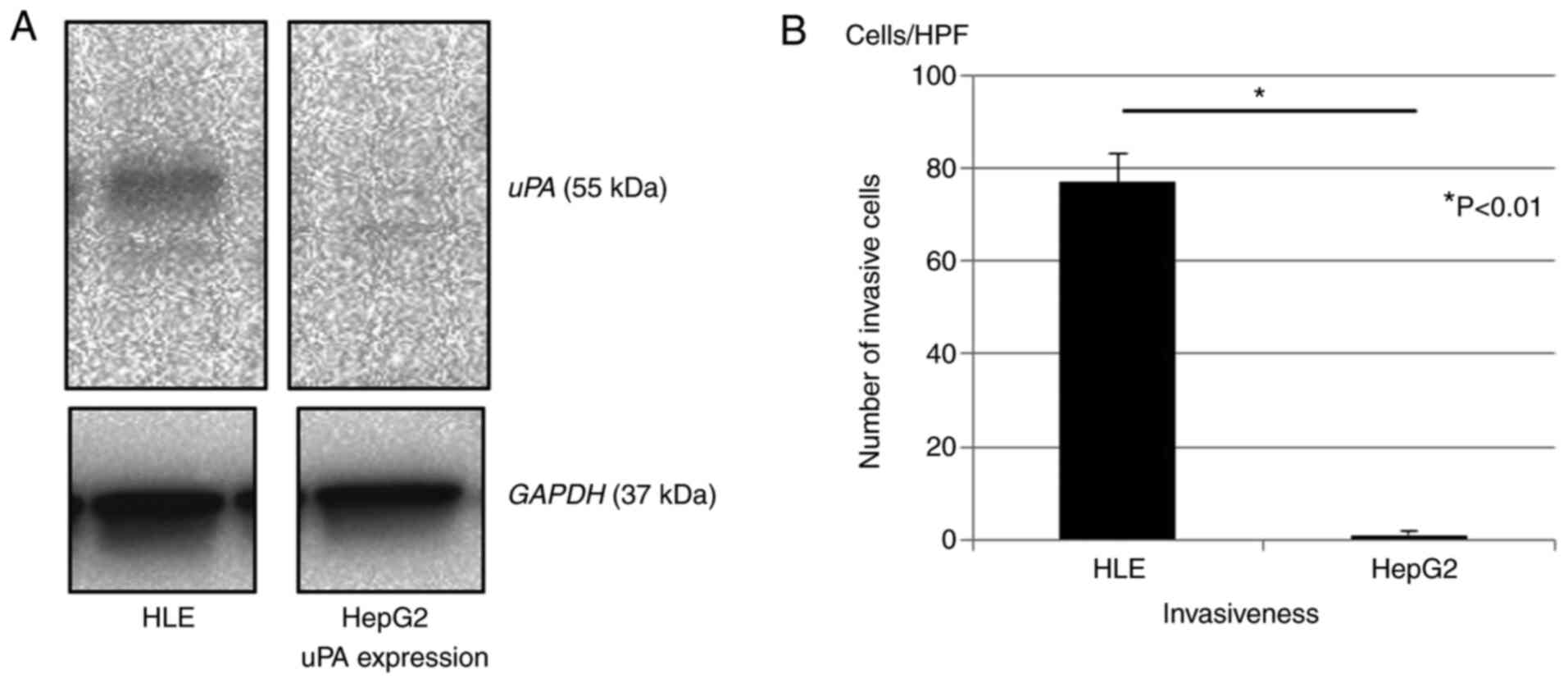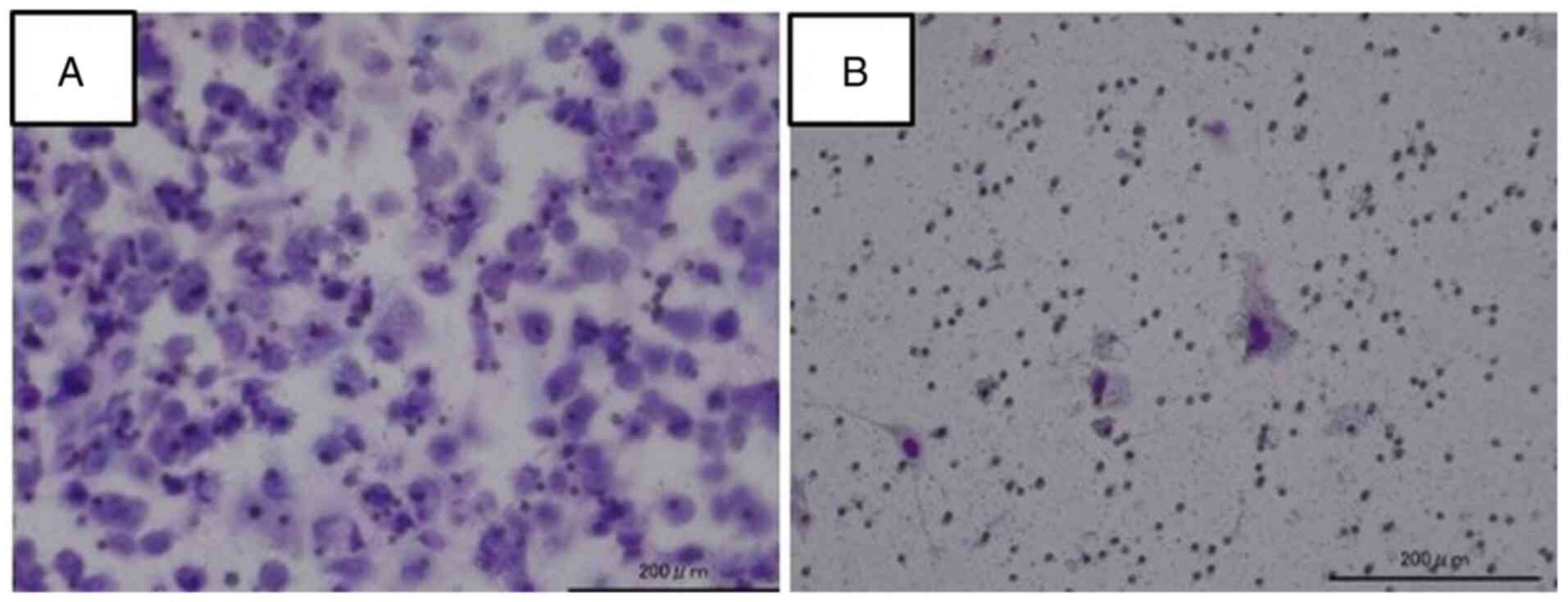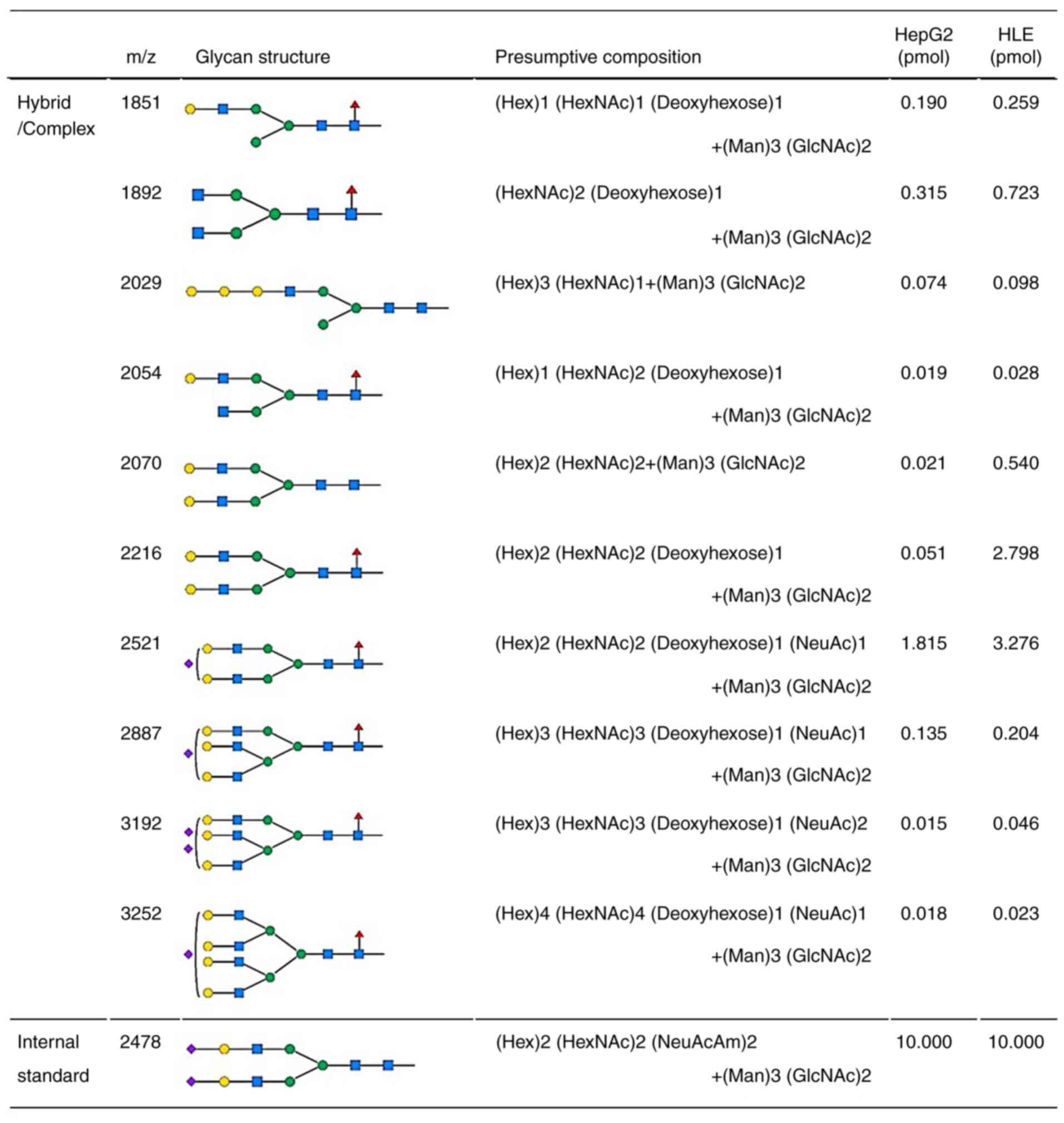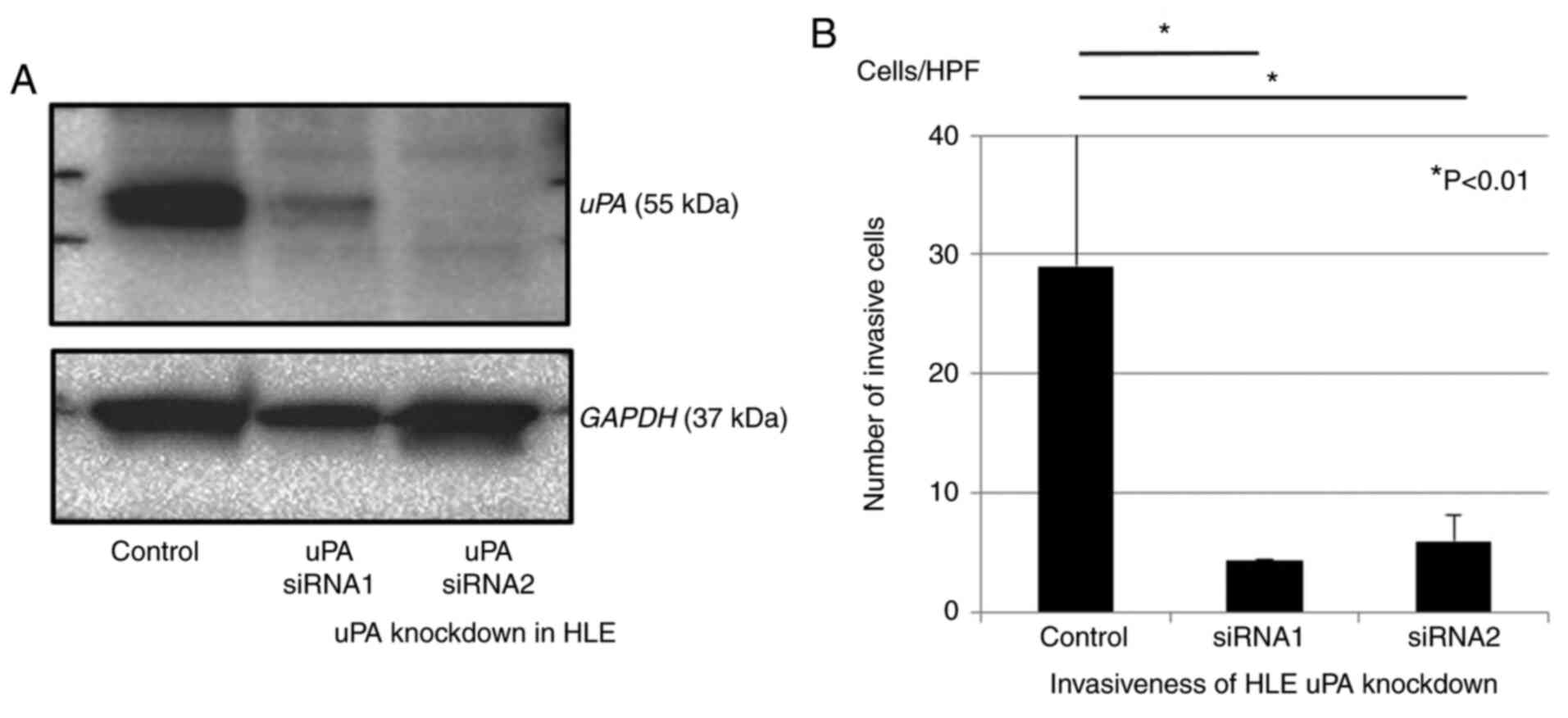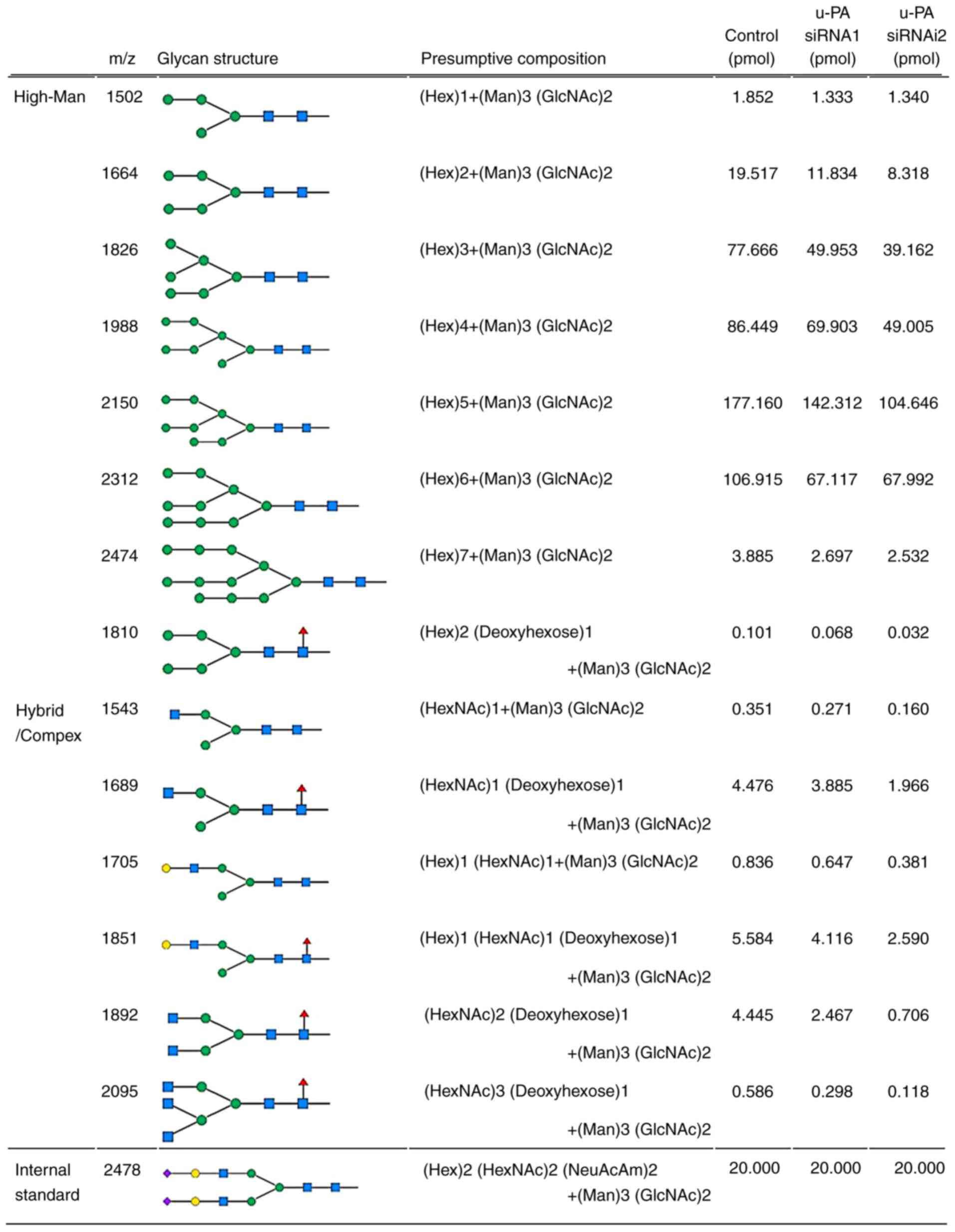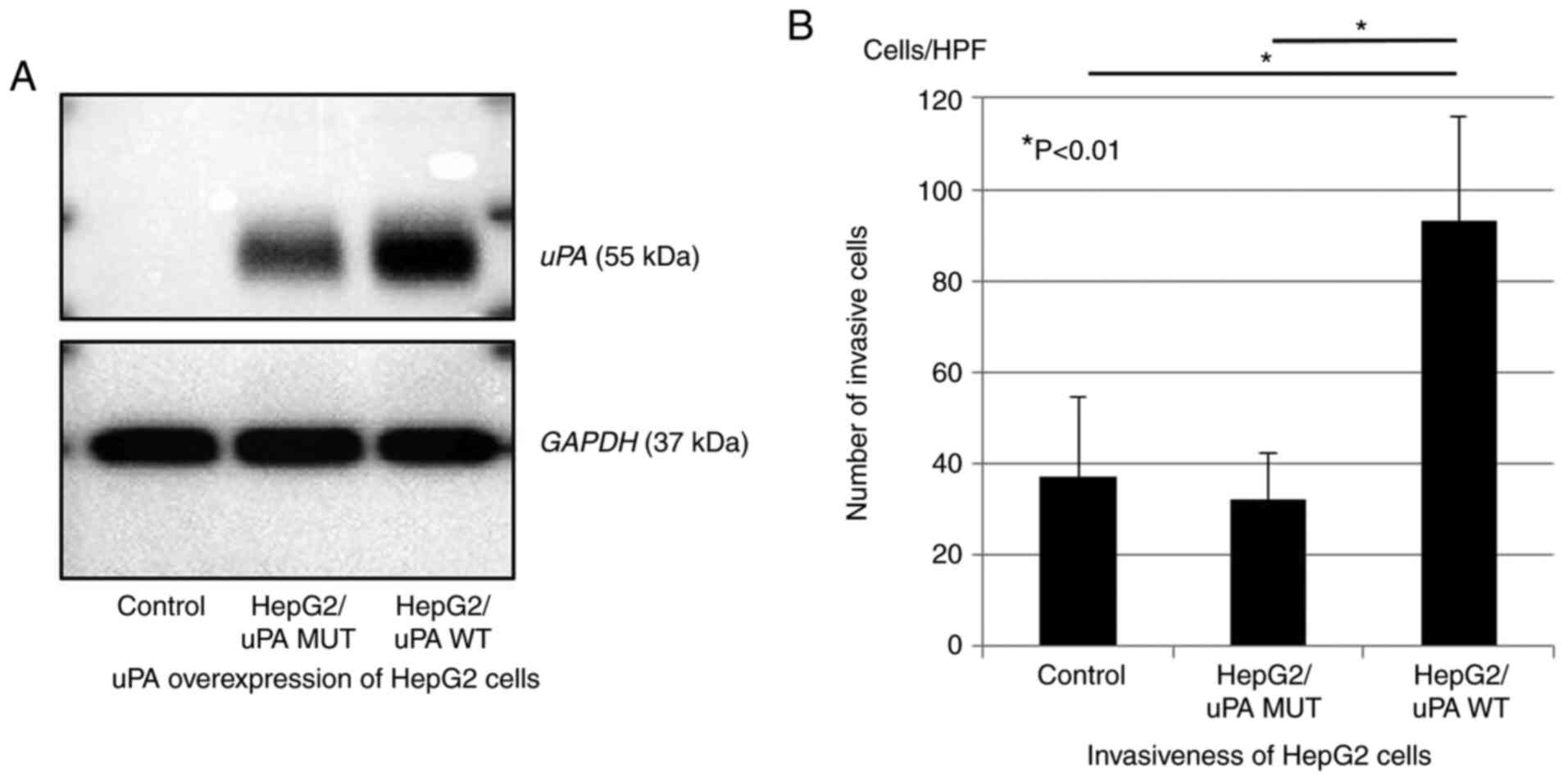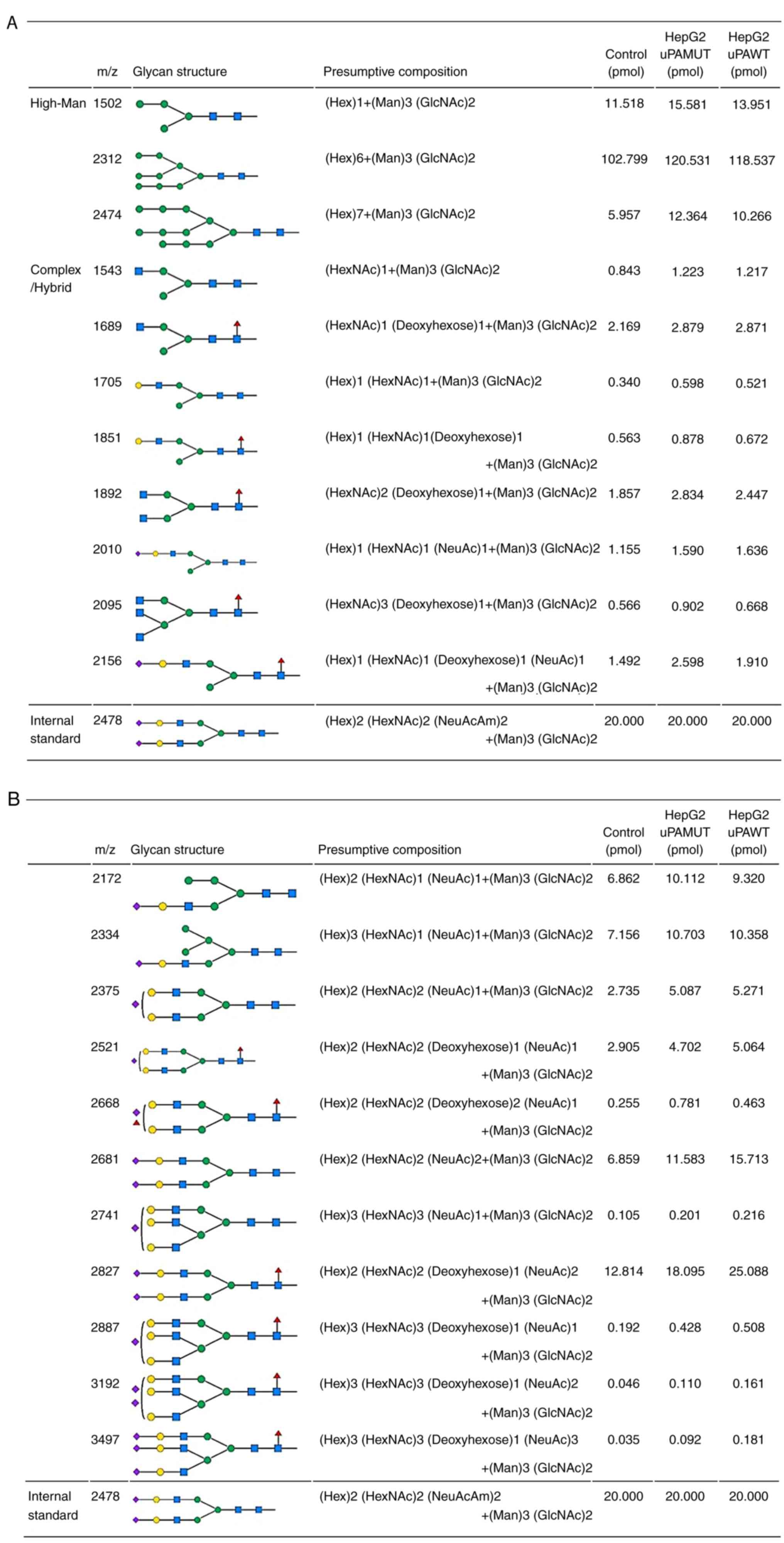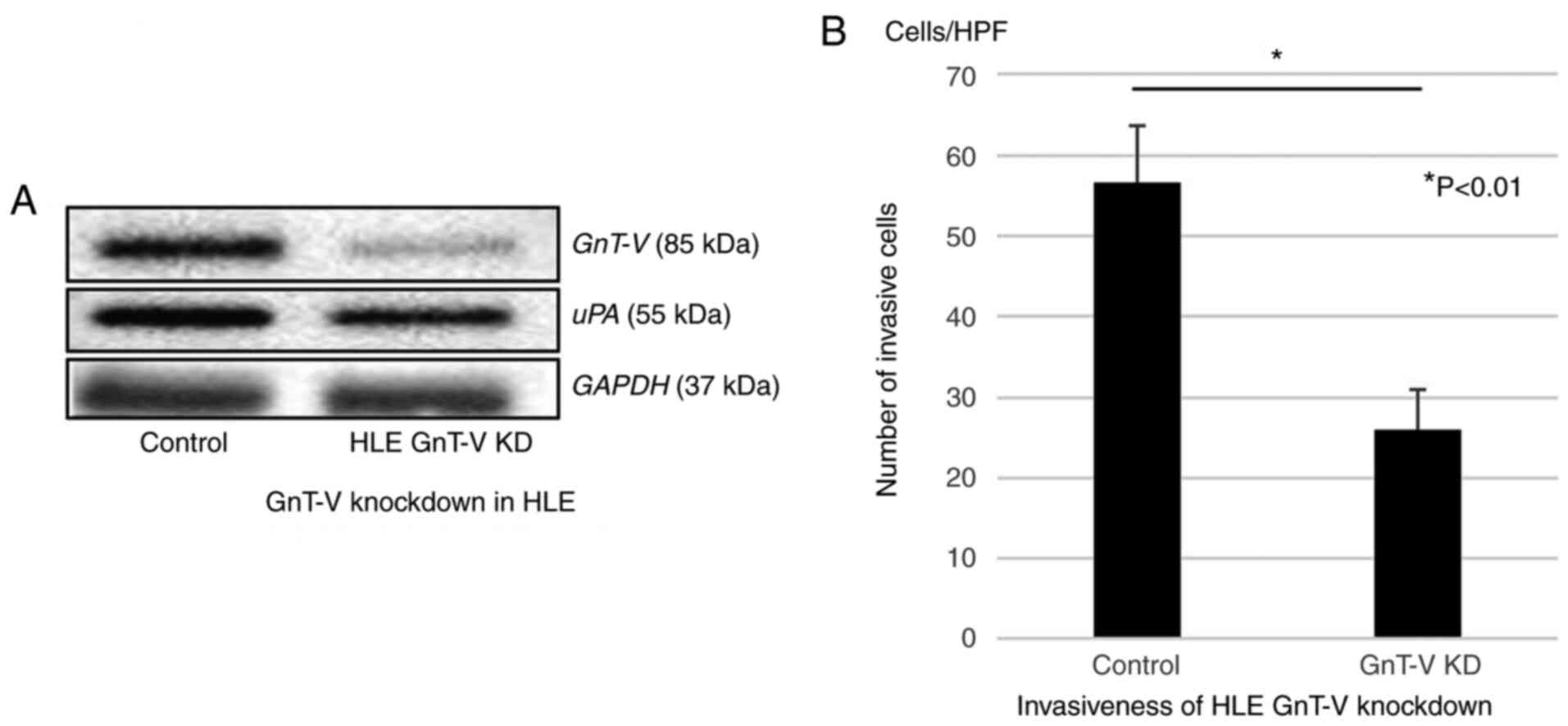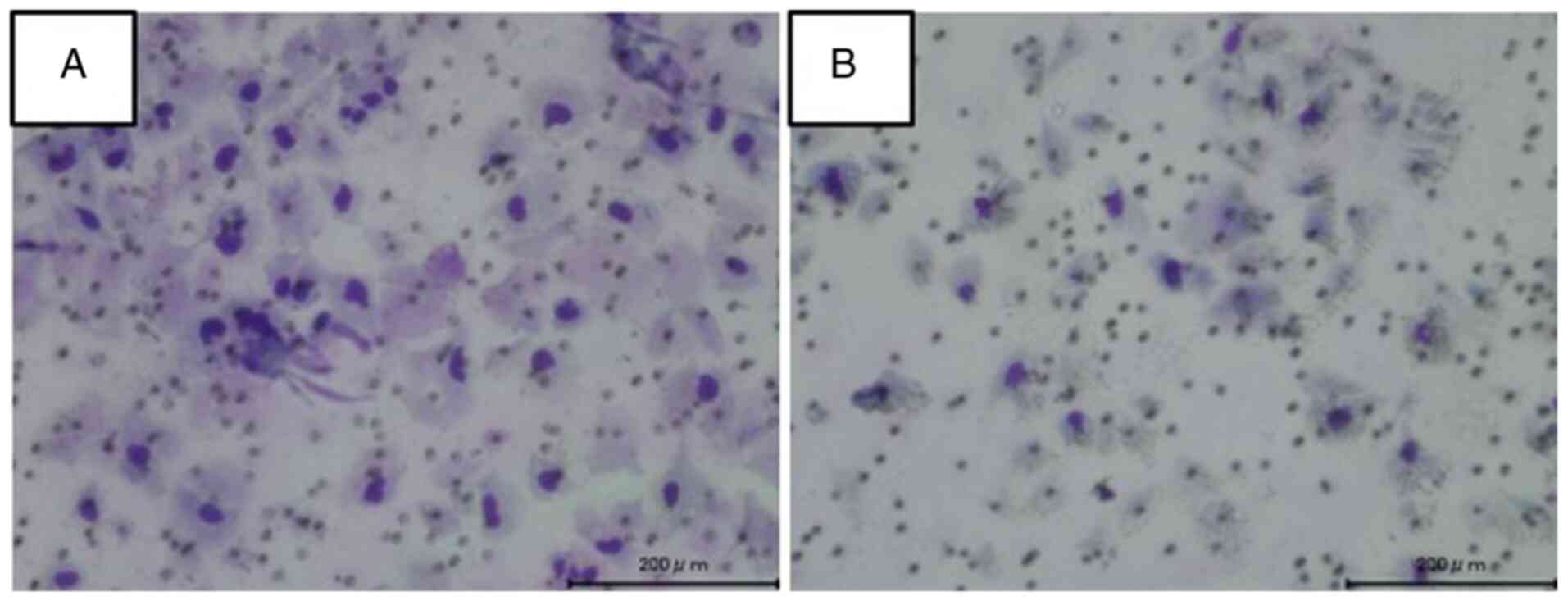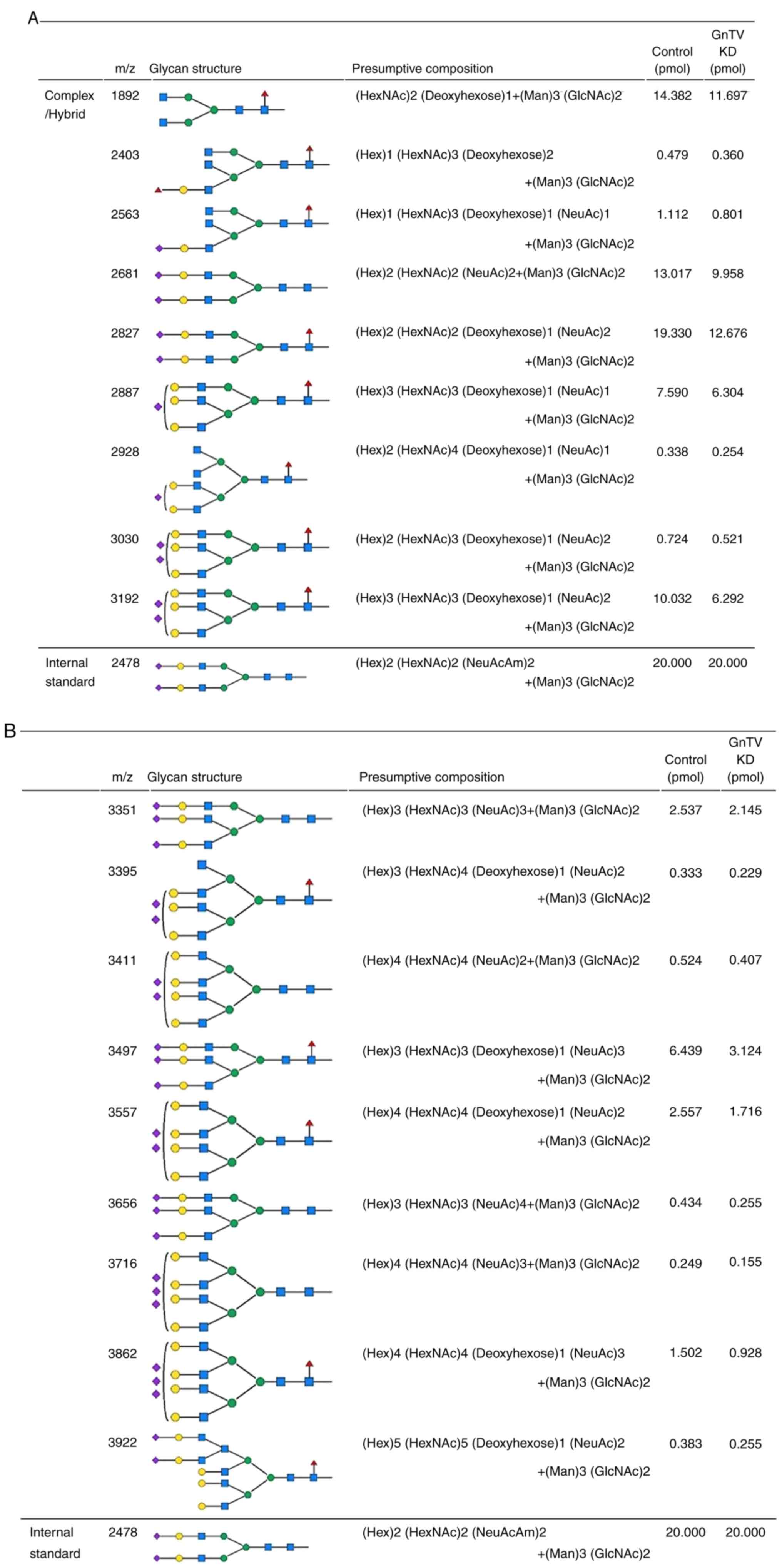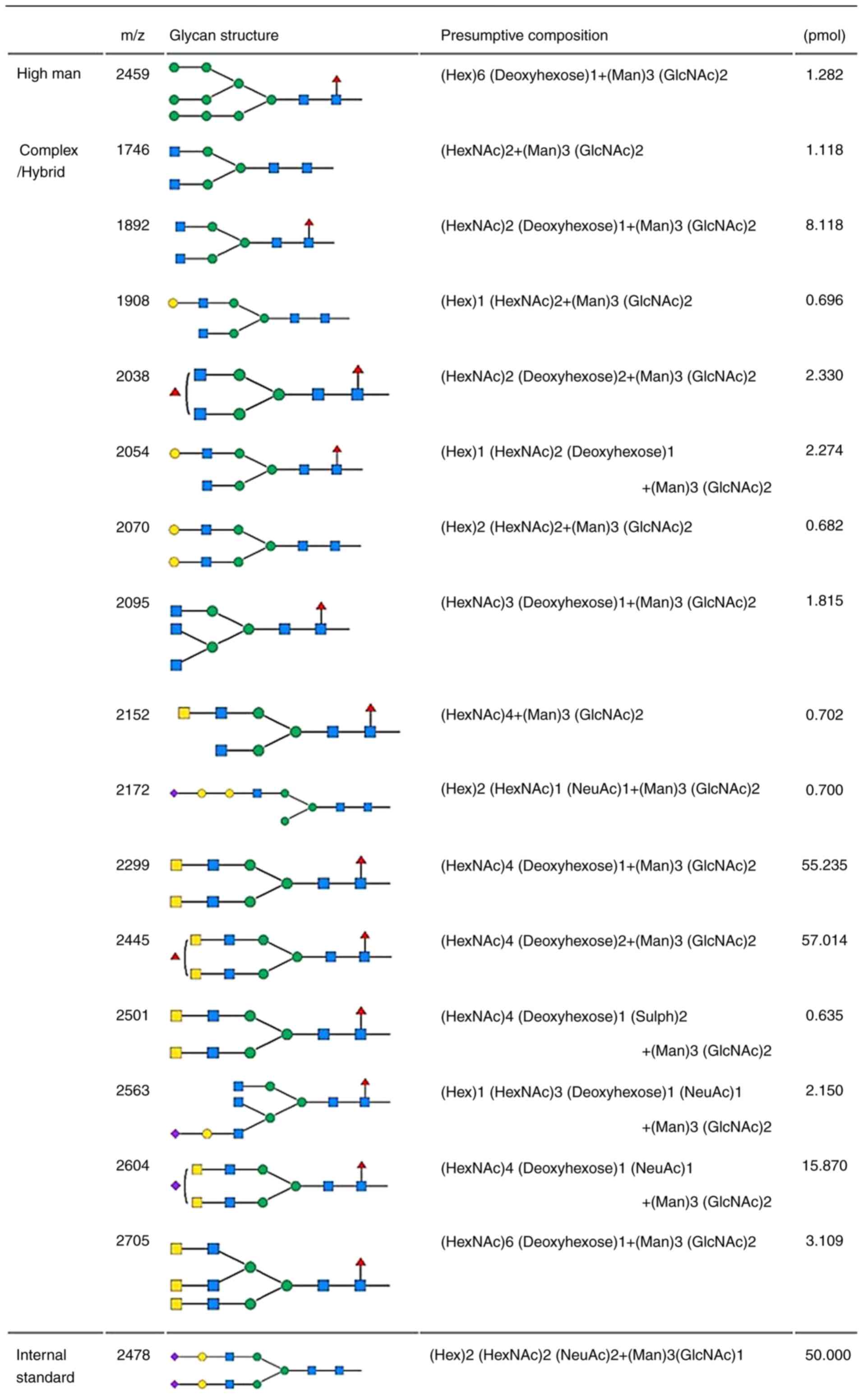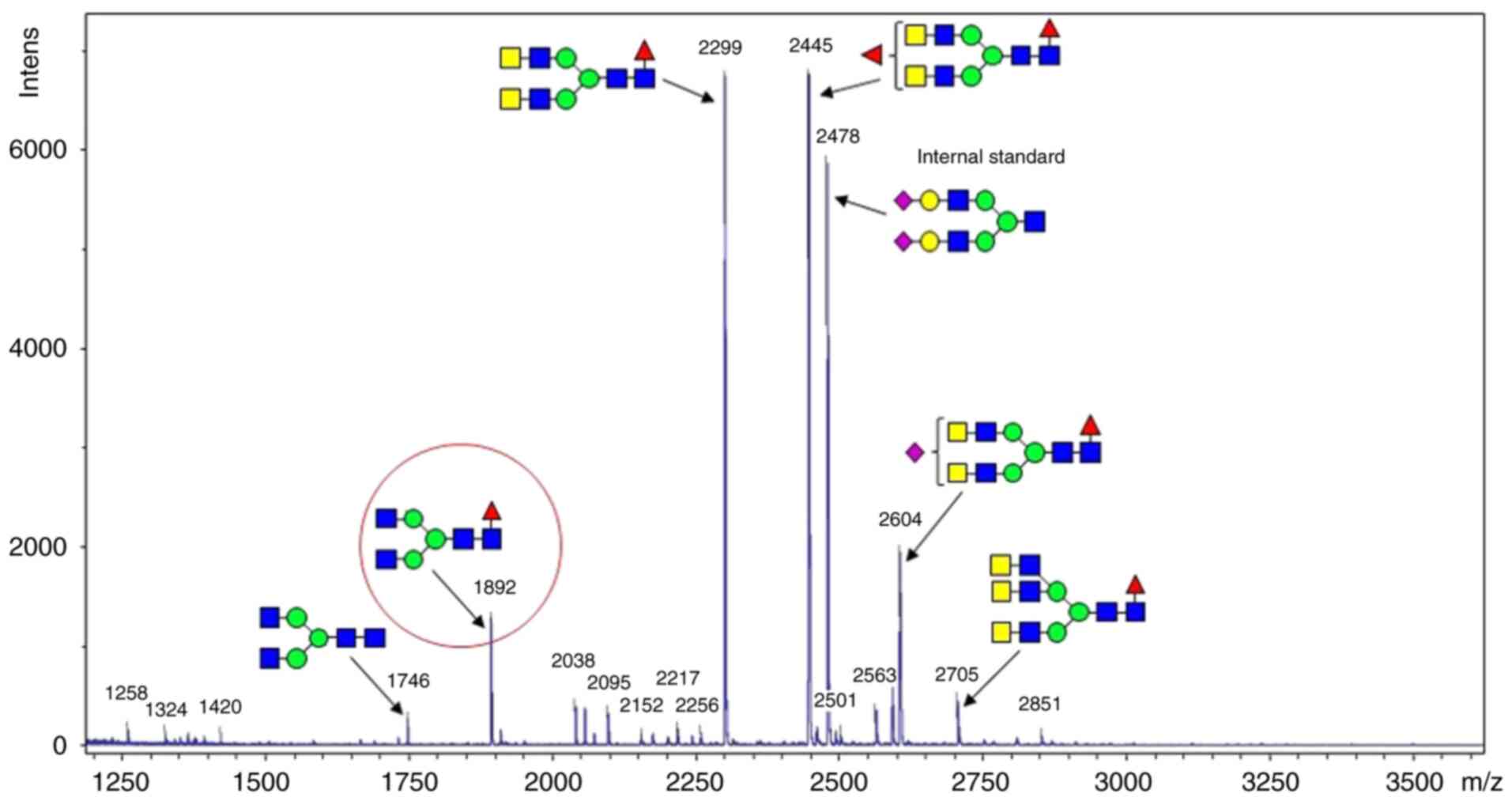|
1
|
Pilobello KT and Mahal LK: Deciphering the
glycocode: The complexity and analytical challenge of glycomics.
Curr Opin Chem Biol. 11:300–305. 2007. View Article : Google Scholar : PubMed/NCBI
|
|
2
|
Ohtsubo K and Marth JD: Glycosylation in
cellular mechanisms of health and disease. Cell. 126:855–867. 2006.
View Article : Google Scholar : PubMed/NCBI
|
|
3
|
Helenius A and Aebi M: Intracellular
functions of N-linked glycans. Science. 291:2364–2369. 2001.
View Article : Google Scholar : PubMed/NCBI
|
|
4
|
Lin G, Zhao R, Wang Y, Han J, Gu Y, Pan Y,
Ren C, Ren S and Xu C: Dynamic analysis of N-glycomic and
transcriptomic changes in the development of ovarian cancer cell
line A2780 to its three cisplatin-resistant variants. Ann Transl
Med. 8:2892020. View Article : Google Scholar : PubMed/NCBI
|
|
5
|
Stephanie H, Jennifer LW, Kamila K, Yoann
R and Manfred W: N-glycomic and transcriptomic changes associated
with CDX1 mRNA expression in colorectal cancer cell lines. Cells.
8:2732019. View Article : Google Scholar
|
|
6
|
Yue W, Feifei X, Yun C and Zhixin T: A
quantitative N-glycoproteomics study of cell-surface N-glycoprotein
markers of MCF-7/ADR cancer stem cells. Anal Bioanal Chem.
412:2423–2432. 2020. View Article : Google Scholar : PubMed/NCBI
|
|
7
|
Miura Y, Hato M, Shinohara Y, Kuramoto H,
Furukawa J, Kurogochi M, Shimaoka H, Tada M, Nakanishi K, Ozaki M,
et al: BlotGlycoABCTM, an integrated glycoblotting technique for
rapid and large scale clinical glycomics. Mol Cell Proteomics.
7:370–377. 2008. View Article : Google Scholar : PubMed/NCBI
|
|
8
|
Kamiyama T, Yokoo H, Furukawa J, Kurogochi
M, Togashi T, Miura N, Nakanishi K, Kamachi H, Kakisaka T, Tsuruga
Y, et al: Identification of novel serum biomarkers of
hepatocellular carcinoma using glycomic analysis. Hepatology.
57:2314–2325. 2013. View Article : Google Scholar : PubMed/NCBI
|
|
9
|
Furukawa J, Tsuda M, Okada K, Kimura T,
Piao J, Tanaka S and Shinohara Y: Comprehensive glycomics of a
multistep human brain tumor model reveals specific glycosylation
patterns related to malignancy. PLoS One. 10:e01283002015.
View Article : Google Scholar : PubMed/NCBI
|
|
10
|
Kang P, Madera M, Alley WR Jr, Goldman R,
Mechref Y and Novotny MV: Glycomic alterations in the
highly-abundant and lesser-abundant blood serum protein fractions
for patients diagnosed with hepatocellular carcinoma. Int J Mass
Spectrom. 305:185–198. 2011. View Article : Google Scholar : PubMed/NCBI
|
|
11
|
Vanhooren V, Liu XE, Franceschi C, Gao CF,
Libert C, Contreras R and Chen C: N-glycan profiles as tools in
diagnosis of hepatocellular carcinoma and prediction of healthy
human ageing. Mech Ageing Dev. 130:92–97. 2009. View Article : Google Scholar : PubMed/NCBI
|
|
12
|
Kirmiz C, Li B, An HJ, Clowers BH, Chew
HK, Lam KS, Ferrige A, Alecio R, Borowsky AD, Sulaimon S, et al: A
serum glycomics approach to breast cancer biomarkers. Mol Cell
Proteomics. 6:43–55. 2007. View Article : Google Scholar : PubMed/NCBI
|
|
13
|
Alley WR Jr, Vasseur JA, Goetz JA, Svoboda
M, Mann BF, Matei DE, Menning N, Hussein A, Mechref Y and Novotny
MV: N-linked glycan structures and their expressions change in the
blood sera of ovarian cancer patients. J Proteome Res.
11:2282–2300. 2012. View Article : Google Scholar : PubMed/NCBI
|
|
14
|
Lee SB, Bose S, Ahn SH, Son BH, Ko BS, Kim
HJ, Chung IY, Kim J, Lee W, Ko MS, et al: Breast cancer diagnosis
by analysis of serum N-glycans using MALDI-TOF mass spectroscopy.
PLoS One. 15:e02310042020. View Article : Google Scholar : PubMed/NCBI
|
|
15
|
Mekkawy AH, Pourgholami MH and Morris DL:
Involvement of urokinase-type plasminogen activator system in
cancer: An overview. Med Res Rev. 34:918–956. 2014. View Article : Google Scholar : PubMed/NCBI
|
|
16
|
Zhou Q, Liang LJ, Peng BG and Zhen YY:
Expression and clinical significance of coagulate and fibrolysis
factors in tissue and plasma from hepatocellular carcinoma
patients. Ai Zheng. 25:1433–1438. 2006.(In Chinese). PubMed/NCBI
|
|
17
|
Itoh T, Hayashi Y, Kanamaru T, Morita Y,
Suzuki S, Wang W, Zhou L, Rui JA, Yamamoto M, Kuroda Y and Itoh H:
Clinical significance of urokinase-type plasminogen activator
activity in hepatocellular carcinoma. J Gastroenterol Hepatol.
15:422–430. 2000. View Article : Google Scholar : PubMed/NCBI
|
|
18
|
Kamiyama T, Une Y, Uchino J and Hamada J:
Hepatocyte growth factor enhances the invasion activity of human
hepatocellular carcinoma cell lines. Int J Oncol. 12:655–659.
1998.PubMed/NCBI
|
|
19
|
Chakraborty AK and Pawelek JM: GnT-V,
macrophage and cancer metastasis: A common link. Clin Exp
Metastasis. 20:365–373. 2003. View Article : Google Scholar : PubMed/NCBI
|
|
20
|
Handerson T, Camp R, Harigopal M, Rimm D
and Pawelek J: Beta1,6-branched oligosaccharides are increased in
lymph node metastases and predict poor outcome in breast carcinoma.
Clin Cancer Res. 11:2969–2973. 2005. View Article : Google Scholar : PubMed/NCBI
|
|
21
|
Handerson T and Pawelek JM:
Beta1,6-branched oligosaccharides and coarse vesicles: A common,
pervasive phenotype in melanoma and other human cancers. Cancer
Res. 63:5363–5369. 2003.PubMed/NCBI
|
|
22
|
Lee SL, Dickson RB and Lin CY: Activation
of hepatocyte growth factor and urokinase/plasminogen activator by
matriptase, an epithelial membrane serine protease. J Biol Chem.
275:36720–36725. 2000. View Article : Google Scholar : PubMed/NCBI
|
|
23
|
Takeuchi T, Harris JL, Huang W, Yan KW,
Coughlin SR and Craik CS: Cellular localization of membrane-type
serine protease 1 and identification of protease-activated
receptor-2 and single-chain urokinase-type plasminogen activator as
substrates. J Biol Chem. 275:26333–26342. 2000. View Article : Google Scholar : PubMed/NCBI
|
|
24
|
Ito Y, Akinaga A, Yamanaka K, Nakagawa T,
Kondo A, Dickson RB, Lin CY, Miyauchi A, Taniguchi N and Miyoshi E:
Co-expression of matriptase and N-acetylglucosaminyltransferase V
in thyroid cancer tissues-its possible role in prolonged stability
in vivo by aberrant glycosylation. Glycobiology. 16:368–374. 2006.
View Article : Google Scholar : PubMed/NCBI
|
|
25
|
Fujitani N, Furukawa J, Araki K, Fujioka
T, Takegawa Y, Piao J, Nishioka T, Tamura T, Nikaido T, Ito M, et
al: Total cellular glycomics allows characterizing cells and
streamlining the discovery process for cellular biomarkers. Proc
Natl Acad Sci USA. 110:2105–2110. 2013. View Article : Google Scholar : PubMed/NCBI
|
|
26
|
Henkin J, Marcotte P and Yang HC: The
plasminogen-plasmin system. Prog Cardiovasc Dis. 34:135–164. 1991.
View Article : Google Scholar : PubMed/NCBI
|
|
27
|
Appella E, Robinson EA, Ullrich SJ,
Stoppelli MP, Corti A, Cassani G and Blasi F: The receptor-binding
sequence of urokinase. A biological function for the growth-factor
module of proteases. J Biol Chem. 262:4437–4440. 1987.PubMed/NCBI
|
|
28
|
Buko AM, Kentzer EJ, Petros A, Menon G,
Zuiderweg ER and Sarin VK: Characterization of a posttranslational
fucosylation in the growth factor domain of urinary plasminogen
activator. Proc Natl Acad Sci USA. 88:3992–3996. 1991. View Article : Google Scholar : PubMed/NCBI
|
|
29
|
Bergwerff AA, Van Oostrum J, Kamerling JP
and Vliegenthart JF: The major N-linked carbohydrate chains from
human urokinase. The occurrence of 4-O-sulfated, (alpha
2–6)-sialylated or (alpha 1–3)-fucosylated
N-acetylgalactosamine(beta 1–4)-N-acetylglucosamine elements. Eur J
Biochem. 228:1009–1019. 1995. View Article : Google Scholar : PubMed/NCBI
|
|
30
|
Kasai S, Arimura H, Nishida M and Suyama
T: Primary structure of single-chain pro-urokinase. J Biol Chem.
260:12382–12389. 1985.PubMed/NCBI
|
|
31
|
McLellan WL, Vetterlein D and Roblin R:
The glycoprotein nature of human plasminogen activators. FEBS Lett.
115:181–184. 1980. View Article : Google Scholar : PubMed/NCBI
|
|
32
|
Sarubbi E, Nolli ML, Robbiati F,
Soffientini A, Parenti F and Cassani G: The differential
glycosylation of human pro-urokinase from various recombinant
mammalian cell lines does not affect activity and binding to PAI-1.
Thromb Haemost. 62:927–933. 1989. View Article : Google Scholar : PubMed/NCBI
|
|
33
|
Li XK, Lijnen HR, Nelles L, Hu MH and
Collen D: Biochemical properties of recombinant mutants of
nonglycosylated single chain urokinase-type plasminogen activator.
Biochim Biophys Acta. 1159:37–43. 1992. View Article : Google Scholar : PubMed/NCBI
|
|
34
|
Saito H, Nishikawa A, Gu J, Ihara Y,
Soejima H, Wada Y, Sekiya C, Niikawa N and Taniguchi N: cDNA
cloning and chromosomal mapping of human
N-acetylglucosaminyltransferase V+. Biochem Biophys Res Commun.
198:318–327. 1994. View Article : Google Scholar : PubMed/NCBI
|
|
35
|
Miyoshi E, Terao M and Kamada Y:
Physiological roles of N-acetylglucosaminyltransferase V(GnT-V) in
mice. BMB Rep. 45:554–559. 2012. View Article : Google Scholar : PubMed/NCBI
|
|
36
|
Taniguchi N, Miyoshi E, Ko JH, Ikeda Y and
Ihara Y: Implication of N-acetylglucosaminyltransferases III and V
in cancer: Gene regulation and signaling mechanism. Biochim Biophys
Acta. 1455:287–300. 1999. View Article : Google Scholar : PubMed/NCBI
|
|
37
|
Cui J, Huang W, Wu B, Jin J, Jing L, Shi
WP, Liu ZY, Yuan L, Luo D, Li L, et al: N-glycosylation by
N-acetylglucosaminyltransferase V enhances the interaction of
CD147/basigin with integrin β1 and promotes HCC metastasis. J
Pathol. 245:41–52. 2018. View Article : Google Scholar : PubMed/NCBI
|
|
38
|
Murata K, Miyoshi E, Kameyama M, Ishikawa
O, Kabuto T, Sasaki Y, Hiratsuka M, Ohigashi H, Ishiguro S, Ito S,
et al: Expression of N-acetylglucosaminyltransferase V in
colorectal cancer correlates with metastasis and poor prognosis.
Clin Cancer Res. 6:1772–1777. 2000.PubMed/NCBI
|
|
39
|
Mehta A, Norton P, Liang H, Comunale MA,
Wang M, Rodemich-Betesh L, Koszycki A, Noda K, Miyoshi E and Block
T: Increased levels of tetra-antennary N-linked glycan but not core
fucosylation are associated with hepatocellular carcinoma tissue.
Cancer Epidemiol Biomarkers Prev. 21:925–933. 2012. View Article : Google Scholar : PubMed/NCBI
|
|
40
|
Ito Y, Miyoshi E, Sakon M, Takeda T, Noda
K, Tsujimoto M, Ito S, Honda H, Takemura F, Wakasa K, et al:
Elevated expression of UDP-N-acetylglucosamine: Alphamannoside
beta1,6 N-acetylglucosaminyltransferase is an early event in
hepatocarcinogenesis. Int J Cancer. 91:631–637. 2001. View Article : Google Scholar : PubMed/NCBI
|
|
41
|
Tian H, Miyoshi E, Kawaguchi N, Shaker M,
Ito Y, Taniguchi N, Tsujimoto M and Matsuura N: The implication of
N-acetylglucosaminyltransferase V expression in gastric cancer.
Pathobiology. 75:288–294. 2008. View Article : Google Scholar : PubMed/NCBI
|
|
42
|
Yamamoto E, Ino K, Miyoshi E, Shibata K,
Takahashi N, Kajiyama H, Nawa A, Nomura S, Nagasaka T and Kikkawa
F: Expression of N-acetylglucosaminyltransferase V in endometrial
cancer correlates with poor prognosis. Br J Cancer. 97:1538–1544.
2007. View Article : Google Scholar : PubMed/NCBI
|
|
43
|
Takahashi N, Yamamoto E, Ino K, Miyoshi E,
Nagasaka T, Kajiyama H, Shibata K, Nawa A and Kikkawa F: High
expression of N-acetylglucosaminyltransferase V in mucinous tumors
of the ovary. Oncol Rep. 22:1027–1032. 2009.PubMed/NCBI
|
|
44
|
Ihara S, Miyoshi E, Ko JH, Murata K,
Nakahara S, Honke K, Dickson RB, Lin CY and Taniguchi N:
Prometastatic effect of N-acetylglucosaminyltransferase V is due to
modification and stabilization of active matriptase by adding beta
1–6 GlcNAc branching. J Biol Chem. 277:16960–16967. 2002.
View Article : Google Scholar : PubMed/NCBI
|
|
45
|
Ihara S, Miyoshi E, Nakahara S, Sakiyama
H, Ihara H, Akinaga A, Honke K, Dickson RB, Lin CY and Taniguchi N:
Addition of beta1-6 GlcNAc branching to the oligosaccharide
attached to Asn 772 in the serine protease domain of matriptase
plays a pivotal role in its stability and resistance against
trypsin. Glycobiology. 14:139–146. 2004. View Article : Google Scholar : PubMed/NCBI
|
|
46
|
Nagae M, Kizuka Y, Mihara E, Kitago Y,
Hanashima S, Ito Y, Takagi J, Taniguchi N and Yamaguchi Y:
Structure and mechanism of cancer-associated
N-acetylglucosaminyltransferase-V. Nat Commun. 9:33802018.
View Article : Google Scholar : PubMed/NCBI
|















